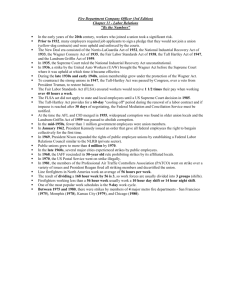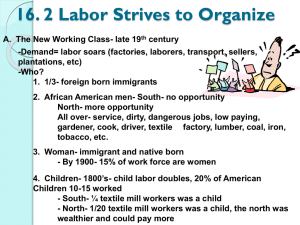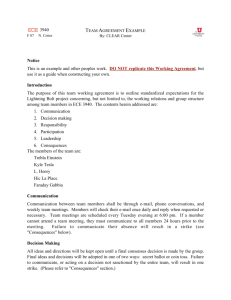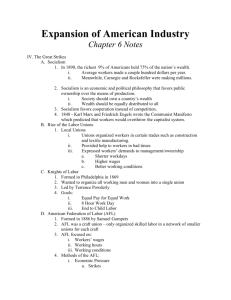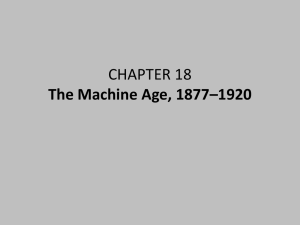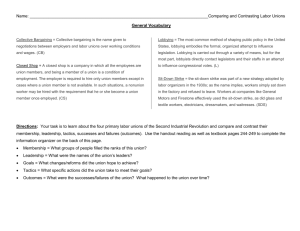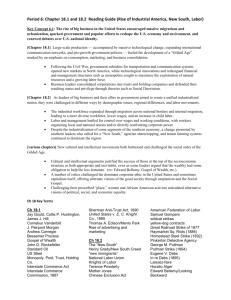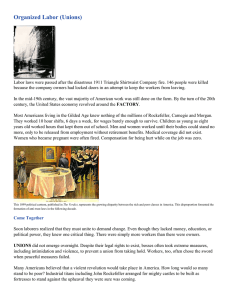20th Century Triumps of American Workers
advertisement
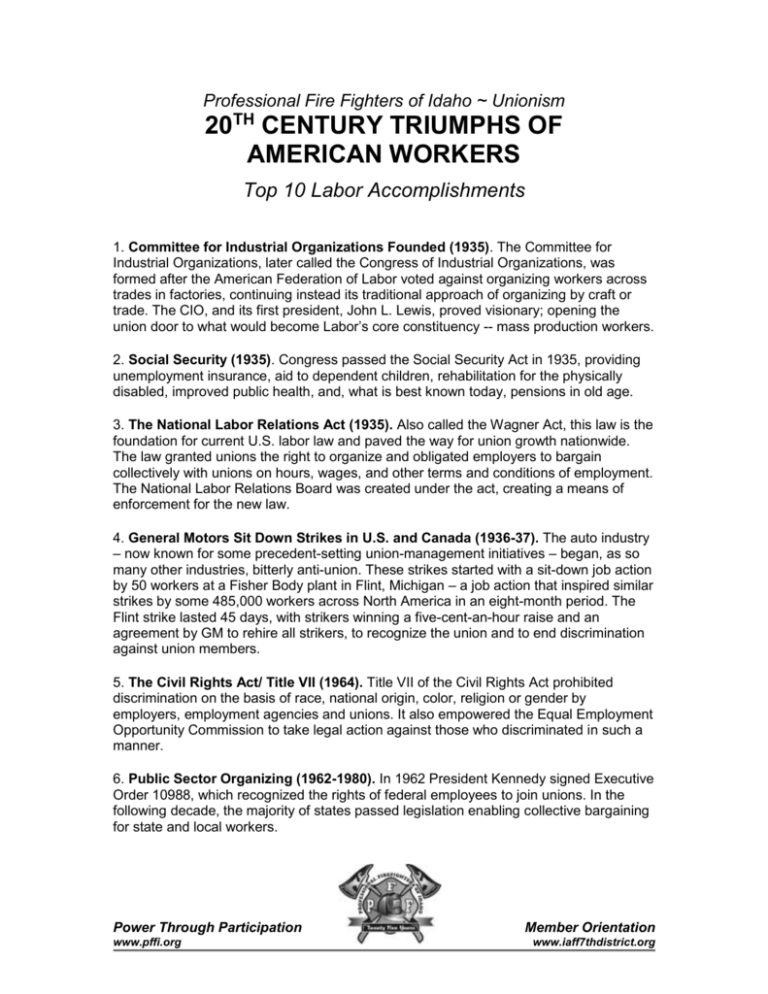
Professional Fire Fighters of Idaho ~ Unionism 20TH CENTURY TRIUMPHS OF AMERICAN WORKERS Top 10 Labor Accomplishments 1. Committee for Industrial Organizations Founded (1935). The Committee for Industrial Organizations, later called the Congress of Industrial Organizations, was formed after the American Federation of Labor voted against organizing workers across trades in factories, continuing instead its traditional approach of organizing by craft or trade. The CIO, and its first president, John L. Lewis, proved visionary; opening the union door to what would become Labor’s core constituency -- mass production workers. 2. Social Security (1935). Congress passed the Social Security Act in 1935, providing unemployment insurance, aid to dependent children, rehabilitation for the physically disabled, improved public health, and, what is best known today, pensions in old age. 3. The National Labor Relations Act (1935). Also called the Wagner Act, this law is the foundation for current U.S. labor law and paved the way for union growth nationwide. The law granted unions the right to organize and obligated employers to bargain collectively with unions on hours, wages, and other terms and conditions of employment. The National Labor Relations Board was created under the act, creating a means of enforcement for the new law. 4. General Motors Sit Down Strikes in U.S. and Canada (1936-37). The auto industry – now known for some precedent-setting union-management initiatives – began, as so many other industries, bitterly anti-union. These strikes started with a sit-down job action by 50 workers at a Fisher Body plant in Flint, Michigan – a job action that inspired similar strikes by some 485,000 workers across North America in an eight-month period. The Flint strike lasted 45 days, with strikers winning a five-cent-an-hour raise and an agreement by GM to rehire all strikers, to recognize the union and to end discrimination against union members. 5. The Civil Rights Act/ Title VII (1964). Title VII of the Civil Rights Act prohibited discrimination on the basis of race, national origin, color, religion or gender by employers, employment agencies and unions. It also empowered the Equal Employment Opportunity Commission to take legal action against those who discriminated in such a manner. 6. Public Sector Organizing (1962-1980). In 1962 President Kennedy signed Executive Order 10988, which recognized the rights of federal employees to join unions. In the following decade, the majority of states passed legislation enabling collective bargaining for state and local workers. Power Through Participation www.pffi.org Member Orientation www.iaff7thdistrict.org Thus Kennedy’s order spearheaded the rapid expansion of public sector organizing at all levels of government. A key event of this period was the tragic death of Martin Luther King, Jr., who had gone to Memphis, Tennessee, in 1968 to support striking city sanitation workers, who were represented by AFSCME. Executive Order 10988 was replaced by the Federal Service Labor-Management Relations Statute, which was included in the Civil Service Reform Act of 1978. 7. Fair Labor Standards Act (1938). The FLSA was the first federal minimum wage law – for non-agricultural labor -- and set a minimum wage of 25-cents an hour. It also banned child labor in all businesses engaged in interstate commerce and provided for overtime compensation. While workers through strikes had won eight-hour-day concessions industry-by-industry, the FLSA made the eight-hour day federal law as well. The limited work day had been Labor’s primary objective since 1866. As broad sweeping as the Act was, it still left out millions of workers. Workers in the agricultural and service industries, interstate commerce and the public sector were not covered by the law. 8. Lawrence (Massachusetts) Textile Strike (1912). This strike is remembered widely for the song written about it "Bread & Roses." It was sung by strikers who had proclaimed they wanted bread to eat and have roses too, meaning they wanted more than a subsistence life. Often called a "landmark" strike, it lasted 63 days and was staged on behalf of 30,000 textile workers—men, women and children -- mostly immigrants. Improving what were intolerable working conditions in the mills of Lawrence, Massachusetts, these people won their strike, despite some violent attempts to end it. 9. Labor's Achievements During WWII. Displaying their patriotism, American unions pledged no strikes and received no layoff concessions for the duration of the war. This action, no doubt, helped Labor achieve a positive image and led to further concessions from business and the government on behalf of American workers. 10. The Occupational Safety and Health Act (1970). While providing a safe job place had been a primary goal of the Labor movement since its inception, it took almost a century – and a conservative Republican president, Richard M. Nixon – to sign the first comprehensive federal legislation requiring employers to provide a workplace "free from recognized hazards that are causing or are likely to cause death or serious physical harm to employees." The law also gave enforcement powers to the Occupational Safety and Health Administration to enforce safe work place rules, including those promulgated by the agency itself. NOTE: The order of these accomplishments was determined by averaging the rankings given by the individual labor experts. David Montgomery, Ph.D. from Yale University, notes that Labor had fought for a law protecting workers from income loss, and that the Act became a keystone for the future, saying, "All subsequent social insurance measures have been built on it." Power Through Participation www.pffi.org Member Orientation www.iaff7thdistrict.org "This was the first union break-through in the heart of corporate industry, which had barred unions since the end of World War I. The strikes ended after the workers won their first UAW contract (though the UAW had earlier won contracts from some smaller companies), and initiated a wave of union victories." David Montgomery, Ph.D., Yale University "Passage of this law dealt a heavy blow to discrimination on the job. The CIO has placed such a law at the top of its list of legislative demands in 1946, but only an effective alliance of civil rights organizations and AFL-CIO lobbyists in the context of grass-roots civil rights action around the country made it possible finally to pass the law." David Montgomery, Ph.D., Yale University "Although the labor movement had won state laws and agencies to protect work conditions from the 1870s on, the 1970 Occupational Health and Safety Act gave a federal agency powers to investigate hazardous conditions and, if necessary, shut them down. It was a major accomplishment of the union movement, and one that is now under heavy attack." David Montgomery, Ph.D., Yale University "Labor's substantive achievements during WWII - the no strike agreement with the War Labor Board was only a part of this. The real achievement was the massive improvements in fringe benefits achieved during this period, along with institutionalization of the principle of grievance arbitration." Thomas A. Kochan, Ph.D., Massachusetts Institute of Technology, Sloan School of Management. Power Through Participation www.pffi.org Member Orientation www.iaff7thdistrict.org
